Indiana is home to a vast variety of birds, from small songbirds to large raptors. With over 400 species of birds, Indiana offers a diverse range of habitats and food sources that attract a wide variety of birds.
From the woodlands of the Hoosier National Forest to the wetlands of the Kankakee River, Indiana provides a variety of habitats for birds to thrive.
Whether it’s a bald eagle soaring over the fields of northern Indiana or a pileated woodpecker tapping away at a tree in southern Indiana, the birds of Indiana offer an incredible array of sights and sounds that make the state a wonderful place for bird-watching.
1. Northern Cardinal
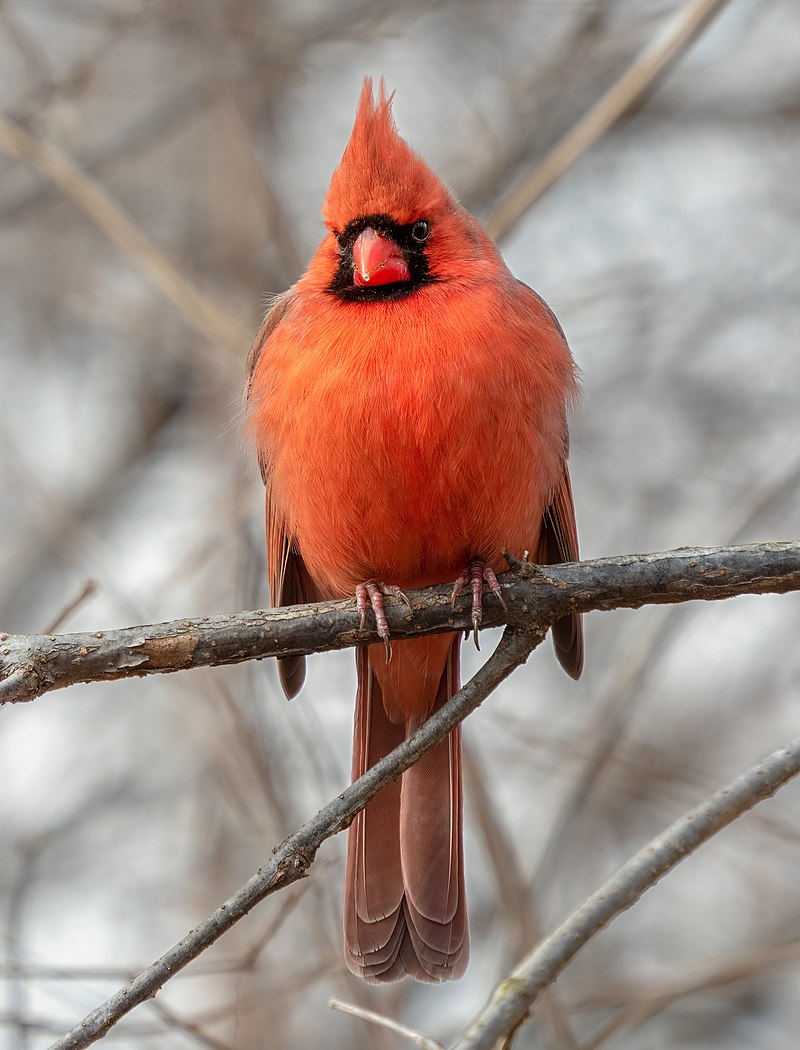
The Northern Cardinal is a beautiful bird, easily identified by its bright red plumage. It can be found in the eastern United States from Maine to Minnesota and south through Mexico and Belize.
Along with its striking coloration, it has a distinctive crest on its head and sharp black facial markings around the eyes.
Despite their small size (measuring 7-9 inches), they are very vocal birds – males sing persistently throughout springtime to attract mates or proclaim their territory.
They typically feed on insects, seeds, and fruits but also enjoy suet at backyard bird feeders.
The female is less brightly colored than her mate but still stands out among other songbirds due to her warm brownish-red feathers.
Cardinals pair for life so you may often see them together in your garden or neighborhood park.
Scientific classification:
| Kingdom | Animalia |
| Phylum | Chordata |
| Class | Aves |
| Order | Passeriformes |
| Family | Cardinalidae |
| Genus | Cardinalis |
| Species | C. cardinalis |
2. Cardinal
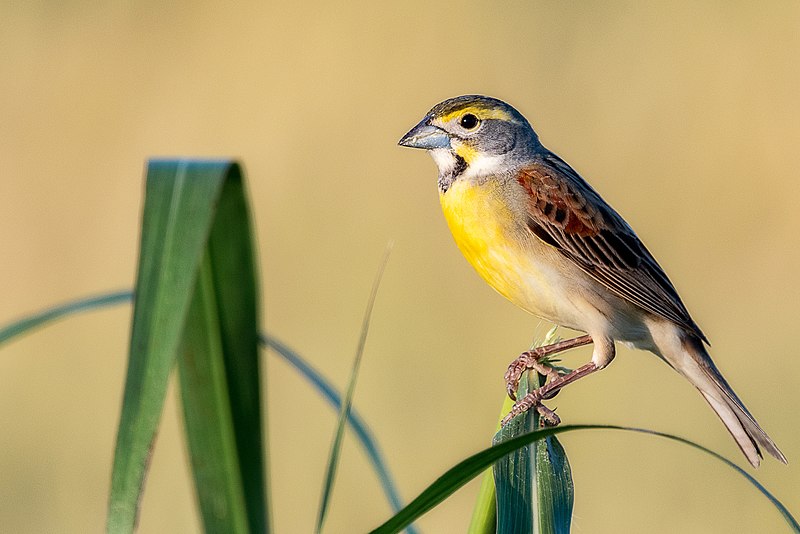
Cardinalidae is a family of passerine birds endemic to the New World that includes cardinals, grosbeaks, and buntings.
This large group has great diversity in its members which range from tanager-like Piranga to warbler-like Granatellus.
They are usually distinguished by their bright plumage with reds, oranges, and yellows being common among them.
Their strong bills enable them to feed on seeds, fruits, and insects as well as other small prey items like lizards or frogs depending upon species.
Cardinals also have loud calls often used for territorial defense and courtship purposes while some can even imitate sounds made by other animals.
These adaptable birds inhabit a variety of habitats across North America making them an important part of many ecosystems there.
Scientific classification:
| Kingdom | Animalia |
| Phylum | Chordata |
| Class | Aves |
| Order | Passeriformes |
| Superfamily | Emberizoidea |
| Family | Cardinalidae Ridgway, 1901 |
3. House Sparrow
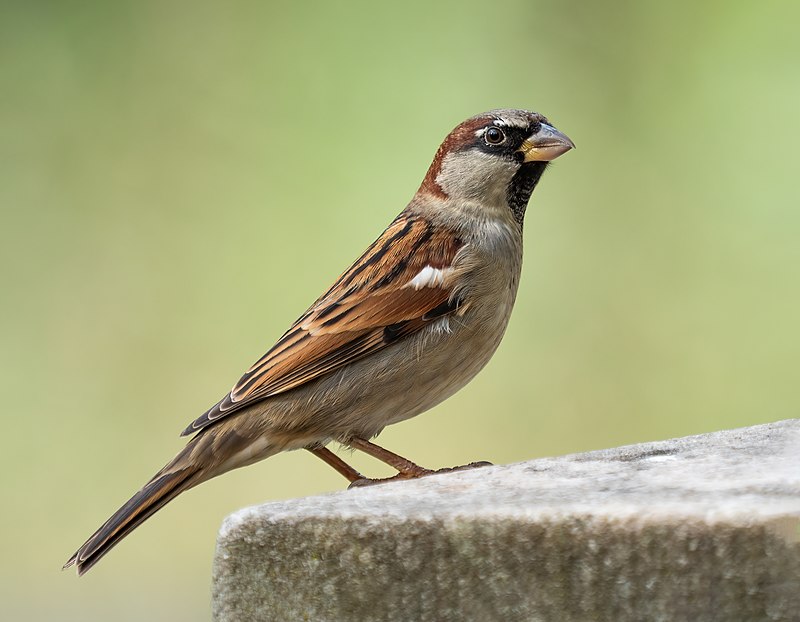
The house sparrow is a small bird of the Passeridae family. It has an average length of 16 cm and weighs 24-39.5 gm.
Females have dull brown and grey plumage, whereas males are brighter, with black, white, and brown markings on their wings and back feathers.
This species is one among 25 different kinds in its genus Passer. These birds are found all around the world mainly near human dwellings where they feed off food scraps from garbage bins or gardens etc..
They also make nests close to houses which makes them even more visible to people living nearby.
House sparrows can be seen hopping around yards looking for food during daytime hours but usually hide in colonies at night time.
Scientific classification:
| Kingdom | Animalia |
| Phylum | Chordata |
| Class | Aves |
| Order | Passeriformes |
| Family | Passeridae |
| Genus | Passer |
| Species | P. domesticus |
4. American Robin

The American robin is a migratory bird, belonging to the true thrush genus and Turdidae family.
It was named after its European counterpart due to the similar reddish-orange breast they both possess; however, they are not related closely.
This species can be seen through most of North America during winter months, as well as in parts of Mexico and Central America where it also breeds.
They have plump bodies with gray upperparts and white underparts that vary from yellow on their throats down to orange toward their bellies.
Robins feed on fruits such as berries or insects like worms which makes them an important part of ecosystems by helping disperse seeds naturally throughout these areas.
Scientific classification:
| Kingdom | Animalia |
| Phylum | Chordata |
| Class | Aves |
| Order | Passeriformes |
| Family | Turdidae |
| Genus | Turdus |
| Species | T. migratorius |
5. House Finch

The House Finch is a species of finch native to western North America and has been introduced in the eastern half of the continent as well as Hawaii.
It’s an average-sized finch with adults measuring 12.5 – 15 cm (5 – 6 inches) long and having wingspans between 20 – 25 cm (8 – 10 inches).
The upperparts are brown, while its underparts range from pale grayish white to yellow depending on subspecies.
Its face is streaked or spotted with reddish coloration; males typically have brighter plumage than females due to sexual dimorphism.
They’re mostly found near human habitations such as farms and gardens where they feed on grains, fruits, insects, etc., making them very popular among birders who want something colorful for their backyard.
Scientific classification:
| Kingdom | Animalia |
| Phylum | Chordata |
| Class | Aves |
| Order | Passeriformes |
| Family | Fringillidae |
| Subfamily | Carduelinae |
| Genus | Haemorhous |
| Species | H. mexicanus |
6. Common Starling

The Common Starling is a medium-sized passerine bird that belongs to the Starling family. It has glossy black plumage with a metallic sheen, and at certain times of the year, it can be speckled with white.
The bill and legs are typically pink or black depending on the season, while its length measures about 8 inches long.
Its diet consists mainly of insects but also includes small fruits and seeds as well as some human food waste.
They live in large flocks which protects predators, although they can become quite aggressive when defending their nesting sites during breeding seasons.
Overall, this species is highly adaptable and widely distributed across many parts of Europe making them one of the most successful birds in the region today.
Scientific classification:
| Kingdom | Animalia |
| Phylum | Chordata |
| Class | Aves |
| Order | Passeriformes |
| Family | Sturnidae |
| Genus | Sturnus |
| Species | S. vulgaris |
7. Blue Jay
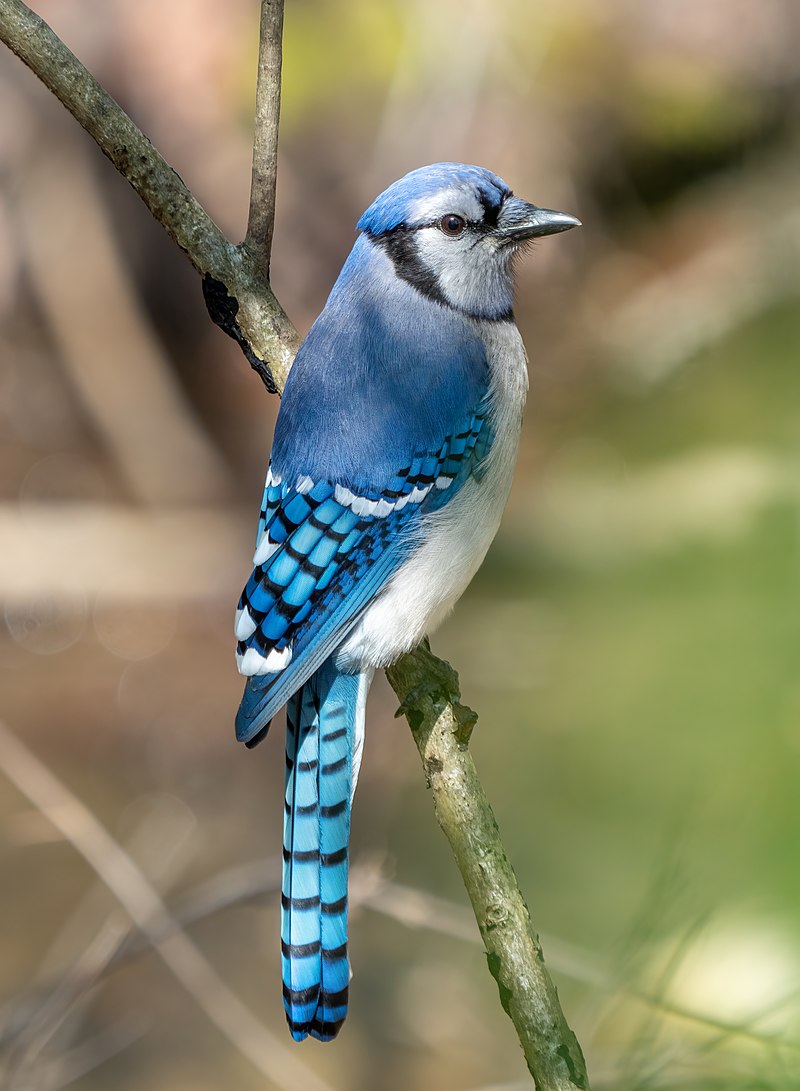
The Blue Jay is a beautiful bird that resides in the eastern and central United States, as well as Newfoundland Canada.
They have an unmistakable blue colored plumage with white markings on their heads and wings.
These birds are highly adaptable to different habitats ranging from deciduous forests to urban areas.
As part of the Corvidae family, they are known for being intelligent problem solvers who will often use tools or mimic vocalizations of other species like hawks when defending their territories.
Their diet consists mostly of insects, seeds, and nuts but can also include small vertebrates such as frogs or lizards if food resources become scarce.
Overall these birds provide much-needed color to our environment while playing important roles in maintaining healthy ecosystems through pollination services and seed dispersal activities.
Scientific classification:
| Kingdom | Animalia |
| Phylum | Chordata |
| Class | Aves |
| Order | Passeriformes |
| Family | Corvidae |
| Genus | Cyanocitta |
| Species | C. cristata |
8. White-Breasted Nuthatch
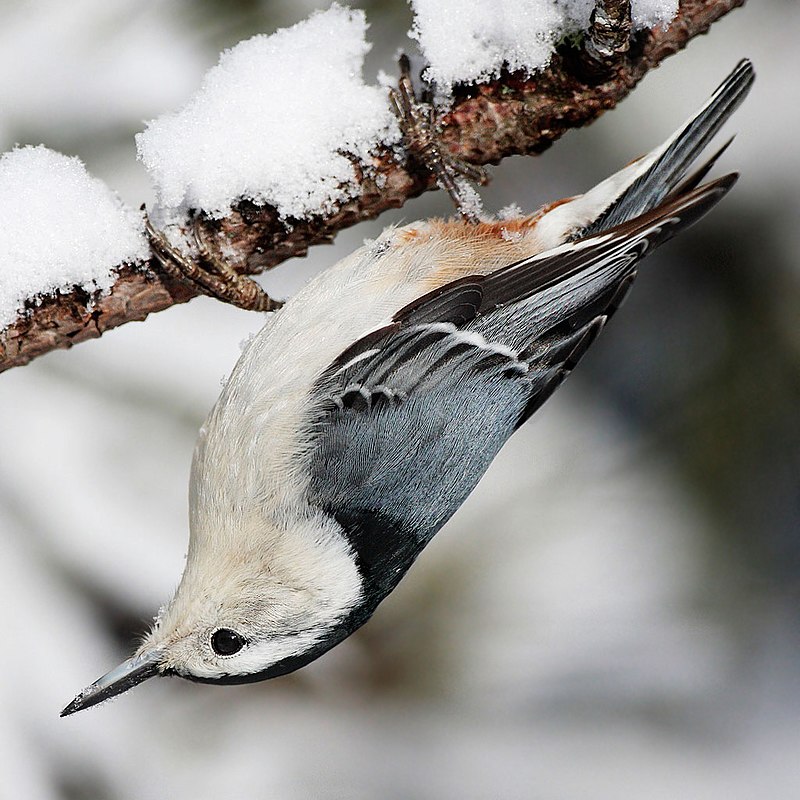
The White-breasted Nuthatch is a medium-sized bird belonging to the nuthatch family Sittidae. It measures around 15.5 cm in length and its color varies throughout its range.
Males have a light blue-grey upperpart, with a black crown and nape whereas females have a dark grey crown instead of a black one.
The underparts are whitish, with a reddish tinge on the sides and flanks while the bill is short and stout with a pale base near the eyes which can be yellow or white depending upon geographic location.
This species feeds mainly on insects but will also eat seeds, nuts, and berries when available.
They prefer open woodlands where they often climb trees searching for food along trunks as well as branches underneath bark crevices creating their nest there too.
Scientific classification:
| Kingdom | Animalia |
| Phylum | Chordata |
| Class | Aves |
| Order | Passeriformes |
| Family | Sittidae |
| Genus | Sitta |
| Species | S. carolinensis |
9. Red-Winged Blackbird

The red-winged blackbird is a beautiful bird found in most of North America and Central America.
Its distinct features include a glossy black body, with white shoulder patches and bright red wing coverts year round.
It prefers wetland habitats such as marshes, ponds, lakeshores, and agricultural fields. During breeding season they inhabit grassy areas near water then move south for the winter months.
For food, they mainly eat insects but also consume wild fruit or grains.
They are very social birds often seen in large flocks during migration times when their unmistakable “conk-la-ree” call can be heard echoing across the sky.
Scientific classification:
| Kingdom | Animalia |
| Phylum | Chordata |
| Class | Aves |
| Order | Passeriformes |
| Family | Icteridae |
| Genus | Agelaius |
| Species | A. phoeniceus |
10. Woodpeckers
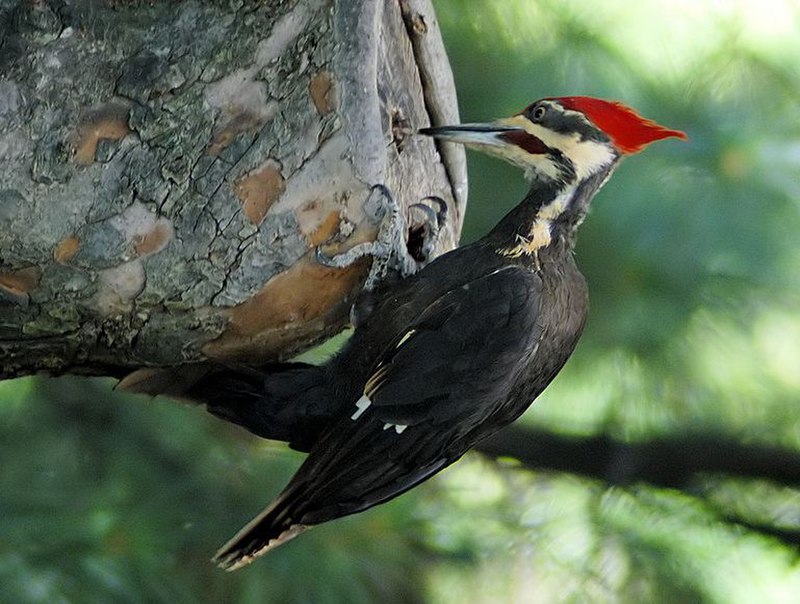
Woodpeckers are an incredibly diverse bird species, found all over the world except for Australia, New Guinea, New Zealand, Madagascar, and the extreme polar regions.
They live in a variety of habitats including forests and woodlands but also rocky hillsides and deserts with no trees.
Their beaks are adapted to pecking at tree bark to find food such as insects or larvae hidden beneath it while they use their long tongues to catch them from deep inside crevices.
Woodpeckers have tough skulls that protect their brains from impact when they bang into things during drumming – a behaviour used by males for territorial signalling and reproduction purposes which is done using strong rapid beats against hollow objects like dead branches or metal poles.
Scientific classification:
| Kingdom | Animalia |
| Phylum | Chordata |
| Class | Aves |
| Order | Piciformes |
| Infraorder | Picides |
| Family | Picidae Leach, 1820 |
11. Song Sparrow
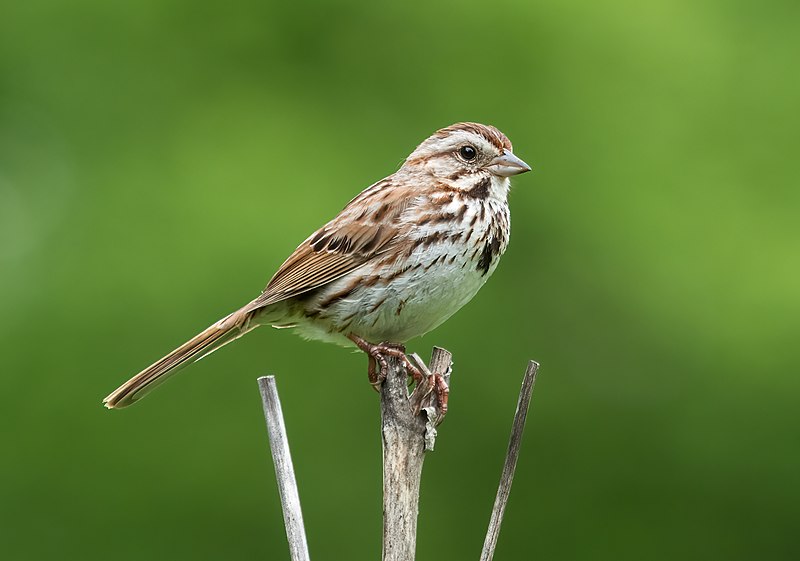
The Song Sparrow (Melospiza melodia) is a small, yet abundant bird found in North America.
They have brown upperparts with dark streaks and are white underneath, complete with a distinct dark brown spot on the breast.
Their cap is also brown and long roughed feathers can be seen sprouting from their neck area.
This sparrow species is highly variable and adaptable to many different environments including dry brush land, wetlands, or open fields.
It has been noted that adult song sparrows will sing even during winter months when other birds remain quiet.
These energetic little animals make for great backyard companions as they flit about singing their lovely melodies.
Scientific classification:
| Kingdom | Animalia |
| Phylum | Chordata |
| Class | Aves |
| Order | Passeriformes |
| Family | Passerellidae |
| Genus | Melospiza |
| Species | M. melodia |
12. Eastern Bluebird
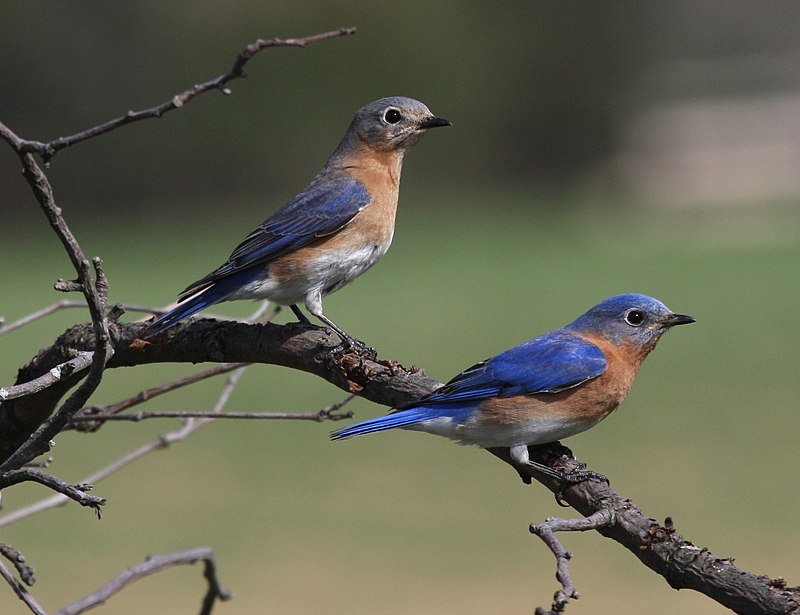
The Eastern bluebird is a small migratory thrush that can be found in open woodlands, farms, and orchards across North America.
The male has bright-blue breeding plumage which makes it easily recognizable by birders.
It produces melodious songs such as jeew, chir-wi, and chiti WEEW wewidoo.
This popular species was declared the state bird of Missouri back in 1927 due to its beauty and charm.
In addition to being beautiful, these birds are also beneficial for farmers because they eat insects like grasshoppers and beetles which damage crops.
They nest in cavities so providing nesting boxes helps them thrive even more.
With their vibrant colors, sweet melodies, and helpful nature it’s easy to see why the Eastern Bluebird is beloved worldwide.
Scientific classification:
| Kingdom | Animalia |
| Phylum | Chordata |
| Class | Aves |
| Order | Passeriformes |
| Family | Turdidae |
| Genus | Sialia |
| Species | S. sialis |
13. Carolina Chickadee
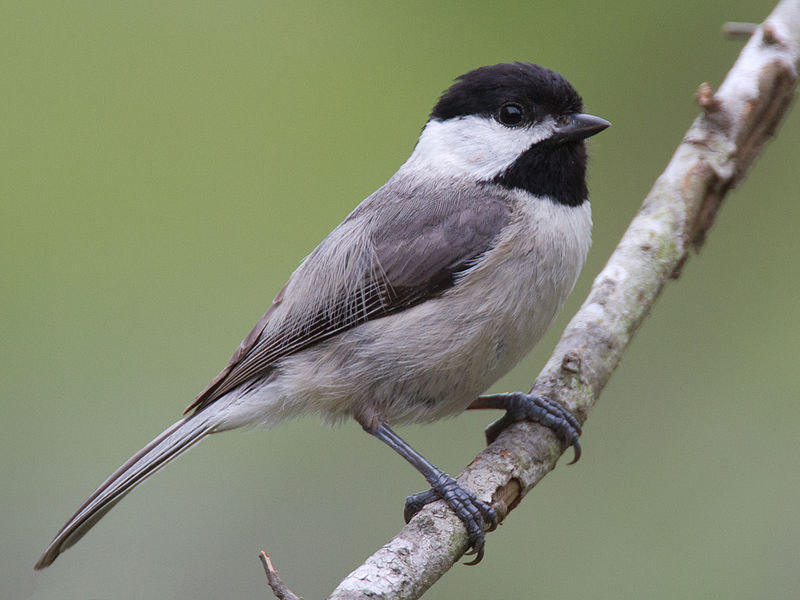
The Carolina Chickadee is a small passerine bird found in the tit family Paridae. It stands out for its distinct black and white, grey-brown feathers with an off-white underside.
This species can be spotted by its call: “chick-a-dee”. The American Ornithologists’ Union has classified them into their genus called Poecile as they differ from other tits due to both genetic data and morphology.
These birds are found all over North America, living in wooded areas near open fields or water sources.
They feed on insects such as caterpillars but also have been known to eat suet at backyard feeders during winter months when food is scarce.
Scientific classification:
| Kingdom | Animalia |
| Phylum | Chordata |
| Class | Aves |
| Order | Passeriformes |
| Family | Paridae |
| Genus | Poecile |
| Species | P. carolinensis |
14. Tufted Titmouse
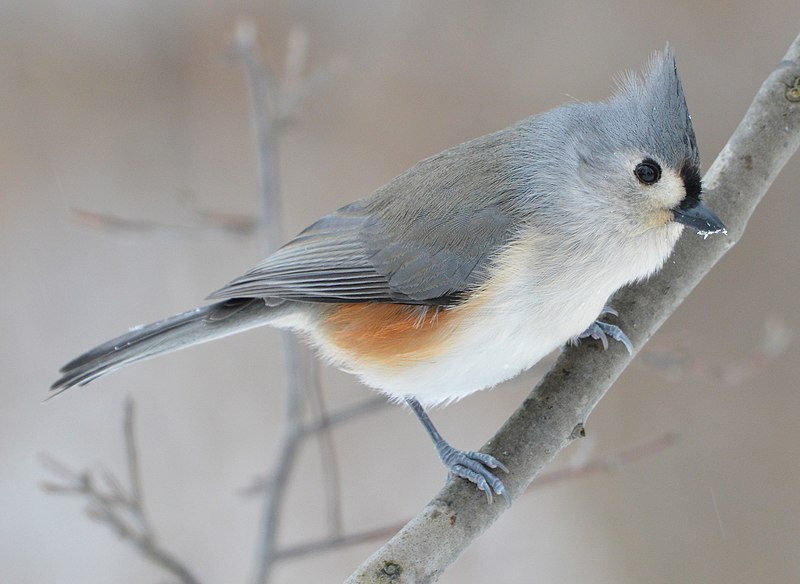
The Tufted Titmouse is a small, cheerful songbird found in North America. It’s part of the tit and chickadee family (Paridae).
It has distinctive white feathers around its eyes, grey-brown wings, and upper body, with a pale tan underside.
Its most notable feature is the black crest on top of its head which gives it an inquisitive look. The male also sports a pinkish breast which can be seen.
When singing from high perches during the spring months. This bird loves to eat sunflower seeds or suet at backyard feeders as well as insects in summertime.
You may even see them poking into crevices and bark looking for food.
They are quite social birds too, being often spotted in mixed flocks alongside other species such as nuthatches and woodpeckers all year round.
Scientific classification:
| Kingdom | Animalia |
| Phylum | Chordata |
| Class | Aves |
| Order | Passeriformes |
| Family | Paridae |
| Genus | Baeolophus |
| Species | B. bicolor |
15. Dark-Eyed Junco

The Dark-eyed Junco is a species of small, grayish sparrows that are found across much of temperate North America and in the Arctic during summer.
It was formally described by Carl Linnaeus in 1766, who named it after its distinctive dark eyes.
This bird has a very variable appearance due to the many different subspecies it contains, making its systematics difficult to unravel.
The plumage varies from white or light gray on their underparts with slate grey backs and wings; black heads with white outer tail feathers; brown head stripes; yellow bills; pink legs and feet; as well as various shades between all these colours.
They also have considerable sexual dimorphism where males tend to be more colorful than females but share similar characteristics such as short tails and rounded bodies – both sexes being around 16 cm long when fully grown.
Scientific classification:
| Kingdom | Animalia |
| Phylum | Chordata |
| Class | Aves |
| Order | Passeriformes |
| Family | Passerellidae |
| Genus | Junco |
| Species | J. hyemalis |
16. American Crow
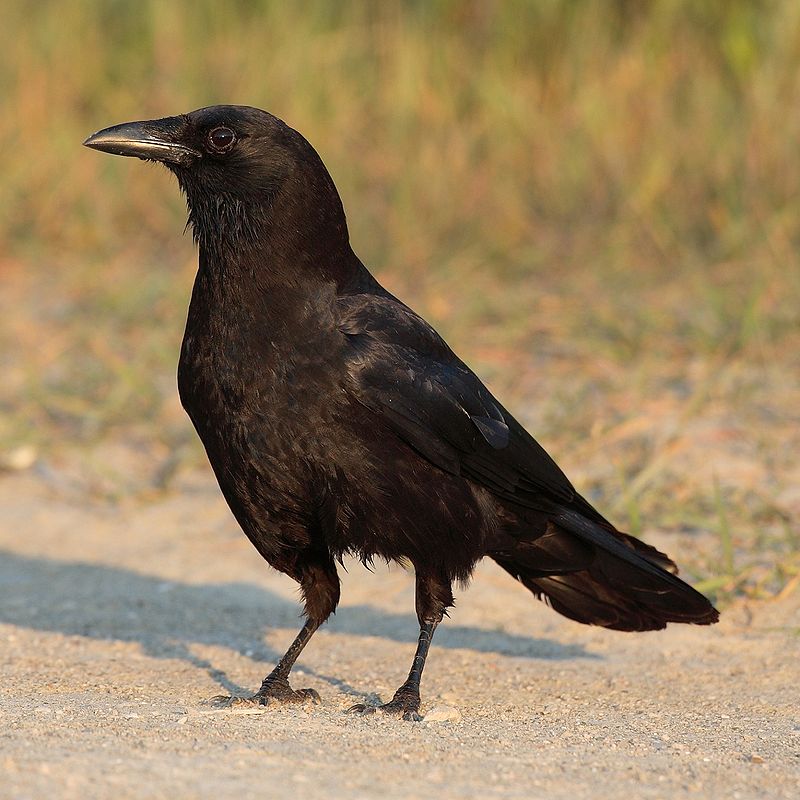
The American crow is a large bird of the Corvidae family, native to most parts of North America.
It is similar in size and structure to its European counterpart, the carrion crow, as well as Eurasia’s hooded crow.
The three species occupy the same ecological niche but are distinguishable by their differences in appearance.
American crows have black feathers covering their entire body with wingspan averaging between 17-21 inches wide for males and 16-19 inches for females.
They feed on insects such as grasshoppers, beetles, and caterpillars; they also eat grains from fields or abandoned farms during winter months when food sources become scarcer.
In addition to feeding habits, American crows can be identified by their distinct call which resembles a “caw” sound that travels long distances over open terrain making them popular among birdwatchers.
Scientific classification:
| Kingdom | Animalia |
| Phylum | Chordata |
| Class | Aves |
| Order | Passeriformes |
| Family | Corvidae |
| Genus | Corvus |
| Species | C. brachyrhynchos |
17. Brown-Headed Cowbird
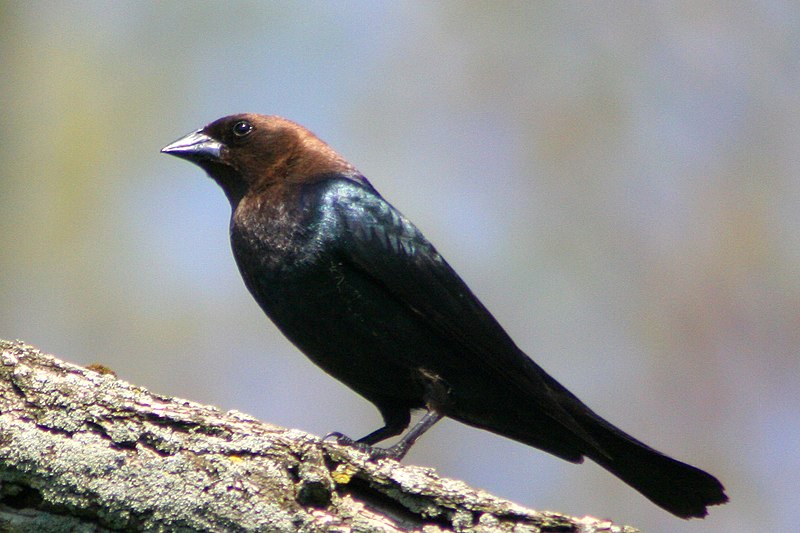
The Brown-headed Cowbird is a small, obligate brood parasitic icterid native to temperate and subtropical North America. It has a brown head with glossy black plumage on the body, wings, and tail feathers.
During summer months it can be found in prairies, grasslands as well as open wooded areas but during winter they migrate southwards towards the United States of Mexico for warmer climates.
They are mainly insectivorous birds that feed on insects like caterpillars or beetles but also consume some grains.
The female bird lays its eggs in nests of other species and then incubates them until hatching time thus leaving their chicks uncared for by themselves.
Scientific classification:
| Kingdom | Animalia |
| Phylum | Chordata |
| Class | Aves |
| Order | Passeriformes |
| Family | Icteridae |
| Genus | Molothrus |
| Species | M. ater |
18. Purple Finch
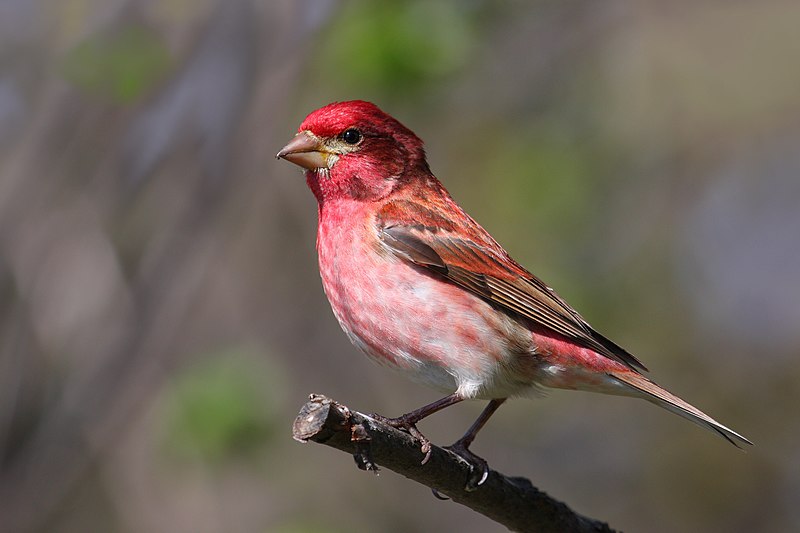
The Purple Finch is a species of finch from North America, belonging to the Fringillidae family.
It’s also known as an “American Rosefinch” due to its resemblance in color and size to some European rosefinches.
Their plumage ranges from pinkish-purple on their heads and wings, with a light brown underside.
They are small birds that measure about 5-6 inches long with short thin beaks for eating seeds and insects.
In addition, they have thick round bodies which help them stay warm during cold winters in the northern parts of their range.
The Purple Finch has adapted well over time making it easier for them to survive even though there are increasing threats posed by humans such as deforestation or habitat destruction caused by development projects near their habitats.
Scientific classification:
| Kingdom | Animalia |
| Phylum | Chordata |
| Class | Aves |
| Order | Passeriformes |
| Family | Fringillidae |
| Subfamily | Carduelinae |
| Genus | Haemorhous |
| Species | H. purpureus |
19. Common Grackle
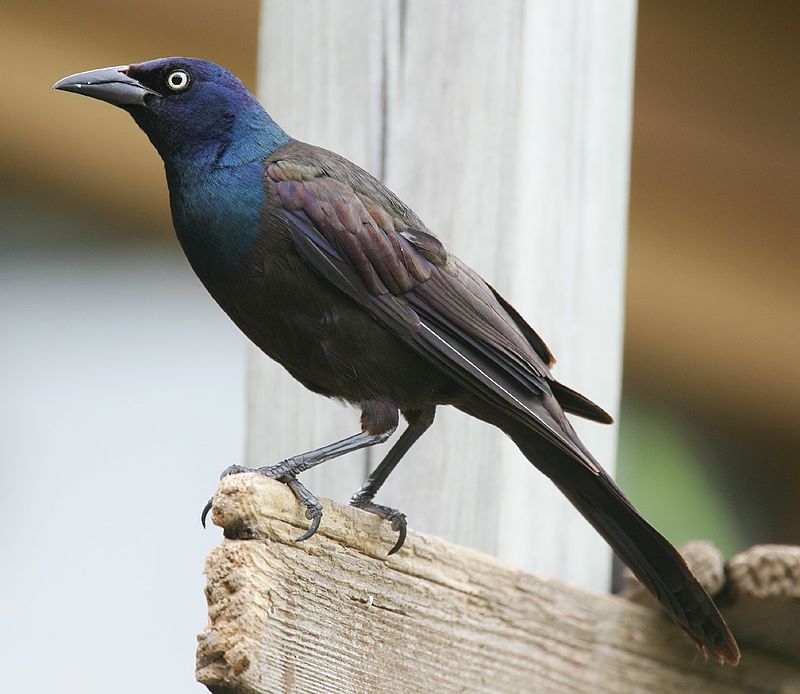
The Common Grackle is a large icterid bird commonly found in North America. It has an iridescent head and pale yellow eyes, which are framed by its long dark bill and long tail.
Males typically have more vivid colors on their heads than females do. These birds can be seen across much of the continent, in fields, forests, wetlands – even urban areas.
They form huge flocks to search for food such as grains or insects that they catch with their bills.
The grackles may also scavenge from human sources like garbage dumps or picnic tables if available. With its colorful plumage and distinct call it’s easy to spot this species amongst other birds.
Scientific classification:
| Kingdom | Animalia |
| Phylum | Chordata |
| Class | Aves |
| Order | Passeriformes |
| Family | Icteridae |
| Genus | Quiscalus |
| Species | Q. quiscula |
20. Carolina Wren
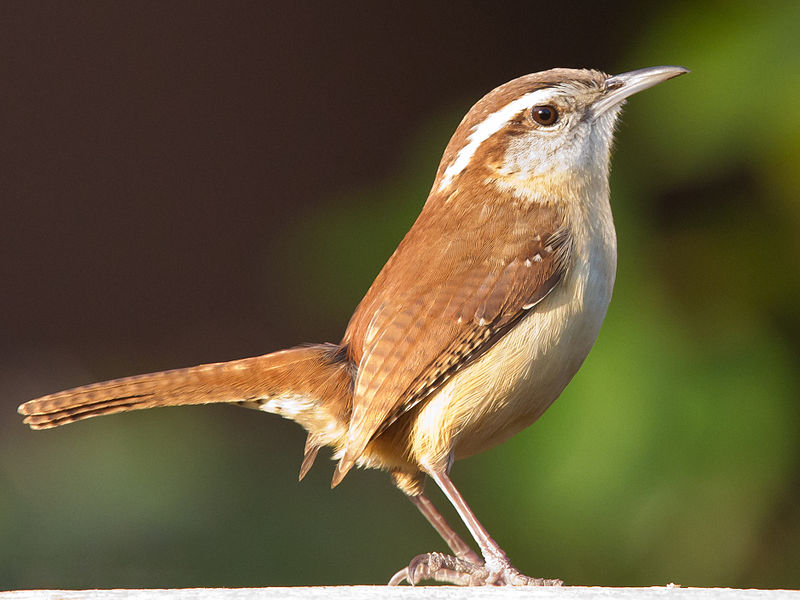
The Carolina wren (Thryothorus ludovicianus) is a medium-sized bird that can be found in the eastern United States, southern Ontario, and northeast Mexico.
They typically live in dense shrubbery or thickets near open areas such as gardens, parks, and woodland edges.
These birds are quite adaptable when it comes to nesting sites – they will build their nests anywhere from tree cavities to manmade boxes.
Their diet consists of insects, spiders, and other invertebrates which they forage for on the ground or among vegetation.
The males have an unmistakable song made up of loud whistles interspersed with trills reminiscent of laughter; you’ll often find these cheerful little birds singing away during early morning hours.
Scientific classification:
| Kingdom | Animalia |
| Phylum | Chordata |
| Class | Aves |
| Order | Passeriformes |
| Family | Troglodytidae |
| Genus | Thryothorus Vieillot, 1816[2] |
| Species | T. ludovicianus |
21. Wrens
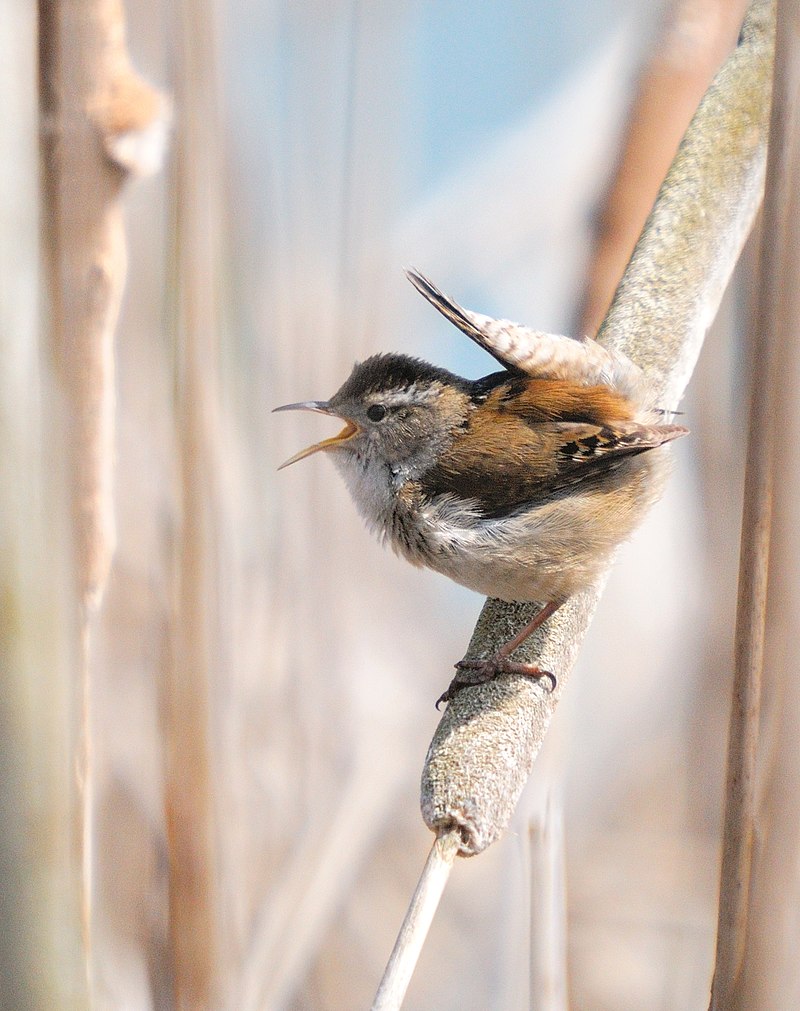
Wrens are a family of small brown passerine birds found mainly in the Americas. They are considered one of the most abundant bird species, with 88 known varieties divided into 19 genera.
The Eurasian wren is the only type that inhabits Europe and other parts of the Old World, where it’s commonly referred to simply as “wren.”
This species has been given its name due to similar-looking unrelated birds living elsewhere such as New Zealand wrasses.
Wrens have tiny bodies with thin bills and long tails which they often hold upright for hours at a time while singing their loud cheery songs from treetops or low shrubs.
Their diet consists mostly of insects but can also include fruits and seeds depending on availability in their habitat range.
Scientific classification:
| Kingdom | Animalia |
| Phylum | Chordata |
| Class | Aves |
| Order | Passeriformes |
| Superfamily | Certhioidea |
| Family | Troglodytidae Swainson, 1832 |
22. Ruby-Throated Hummingbird
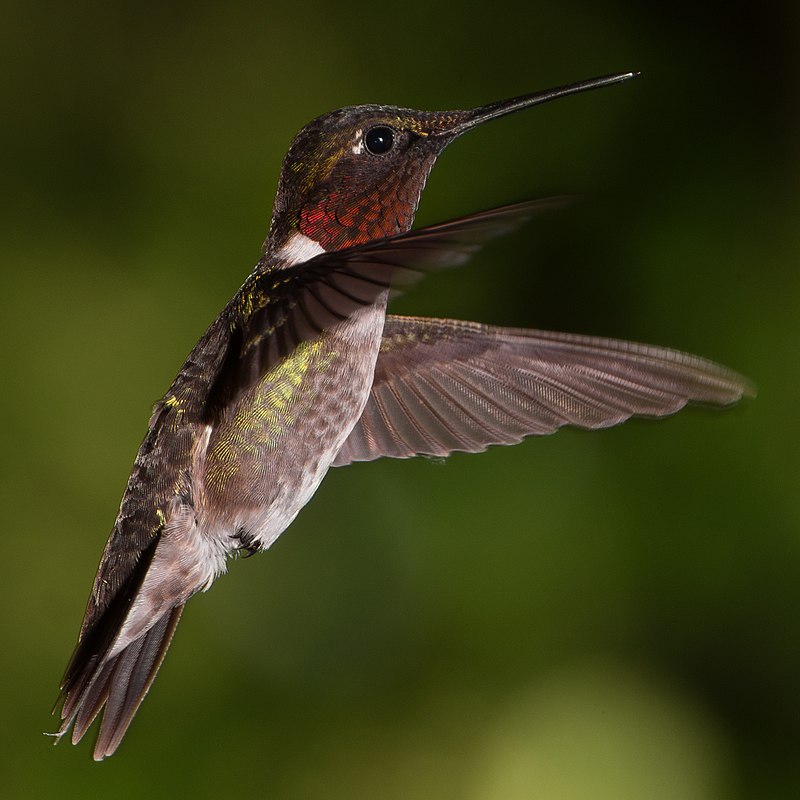
The ruby-throated hummingbird (Archilochus colubris) is a species of hummingbird that has an impressive migration pattern, spending the winter in Central America, Mexico, and Florida before flying to Canada and other parts of Eastern North America for the breeding season.
It’s by far the most common type seen east of the Mississippi River in North America.
Formally described by Swedish naturalist Carl Linnaeus in 1758, this tiny bird has bright metallic green upperparts with white underparts, a small black bill, and a red throat patch which gives it its name; they measure around 3 inches long on average.
They feed primarily on nectar from flowers but also eat insects such as flies or mosquitoes for extra protein during their migrations or when raising young chicks.
Scientific classification:
| Kingdom | Animalia |
| Phylum | Chordata |
| Class | Aves |
| Order | Apodiformes |
| Family | Trochilidae |
| Genus | Archilochus |
| Species | A. colubris |
23. White-Throated Sparrow
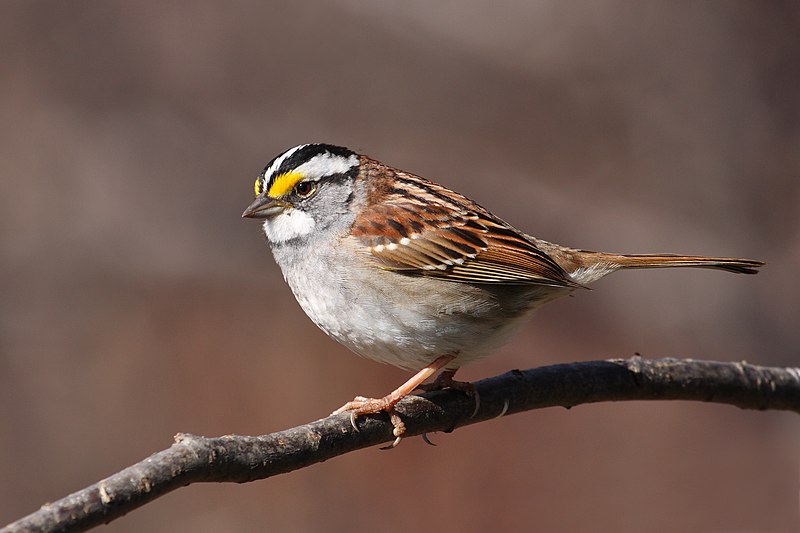
The White-throated Sparrow is a small passerine bird of the New World sparrow family Passerellidae.
It has distinctive yellow and black stripes on its head, white throat, and chest with grey back and wings, along with light brown legs.
The scientific name “Zonotrichia albicollis” comes from Ancient Greek for ‘band’ (ζώνη) referring to its distinctive striped crown, and Latin for ‘white neck’ (albus collum).
These birds are usually found in wooded areas such as coniferous forests or deciduous habitats in North America where they feed mainly on insects during summer months; transitioning to seeds during winter.
They build their nests near ground level using grasses, twigs, or moss lined with feathers.
White-throated Sparrows may be solitary but also form flocks when migrating southward each fall season which typically occurs over mid-late October through November depending on location within range.
Scientific classification:
| Kingdom | Animalia |
| Phylum | Chordata |
| Class | Aves |
| Order | Passeriformes |
| Family | Passerellidae |
| Genus | Zonotrichia |
| Species | Z. albicollis |
24. Baltimore Oriole
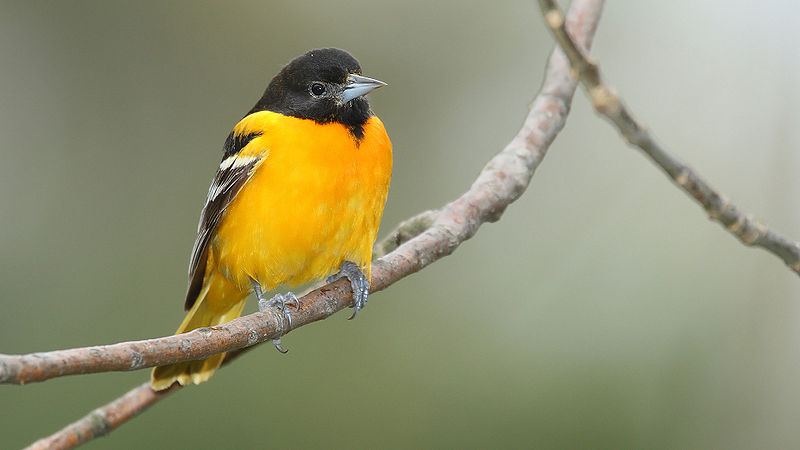
The Baltimore Oriole is a small, blackbird-like bird found in eastern North America. It’s named for the resemblance of its male colors to those on Lord Baltimore’s coat-of-arms from the 17th century.
These birds migrate and breed during springtime and are quite common in their habitats.
Studies have shown that this species interbreeds with western Bullock’s orioles, leading both to be classified as a single species – Icterus galbula.
The males typically have orange feathers along the chest, back, wings, and tail while females display tan or yellowish shades instead of bright orange ones like males do.
Both sexes share white wing bars and dark brown eyes which makes them easily distinguishable among other birds.
They can often be seen flitting around trees feeding off nectar buds or insects such as grasshoppers & caterpillars they catch while flying around.
Scientific classification:
| Kingdom | Animalia |
| Phylum | Chordata |
| Class | Aves |
| Order | Passeriformes |
| Family | Icteridae |
| Genus | Icterus |
| Species | I. galbula |
25. Red-headed woodpecker
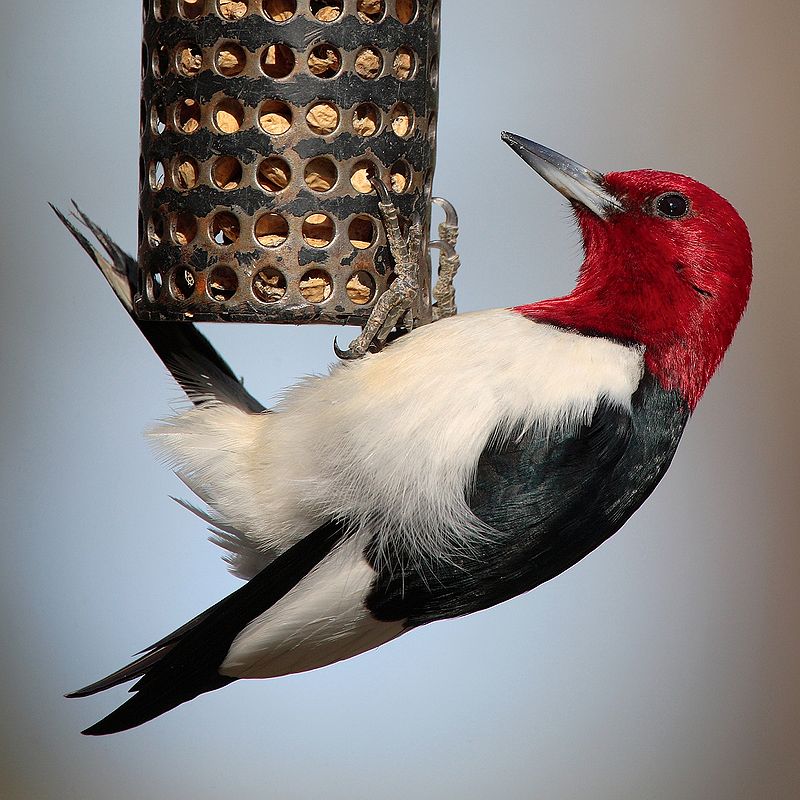
The red-headed woodpecker is a mid-sized bird found in temperate North America. It has striking plumage, with its head and neck being bright red while the rest of its body is primarily black and white.
Its wings are rounder than other similar species, allowing it to maneuver through tight spaces easily when searching for food or shelter.
The breeding habitat of this bird consists mainly of open fields across Canada and the east-central United States.
Despite facing threats such as deforestation, urbanization, predation from larger birds, and collisions with windows or cars due to their inquisitive nature.
These birds remain listed on IUCN’s Red List as least concern thanks largely in part to conservation efforts by local governments and organizations dedicated to protecting wildlife habitats.
Scientific classification:
| Kingdom | Animalia |
| Phylum | Chordata |
| Class | Aves |
| Order | Piciformes |
| Family | Picidae |
| Genus | Melanerpes |
| Species | M. erythrocephalus |
26. Red-Tailed Hawk
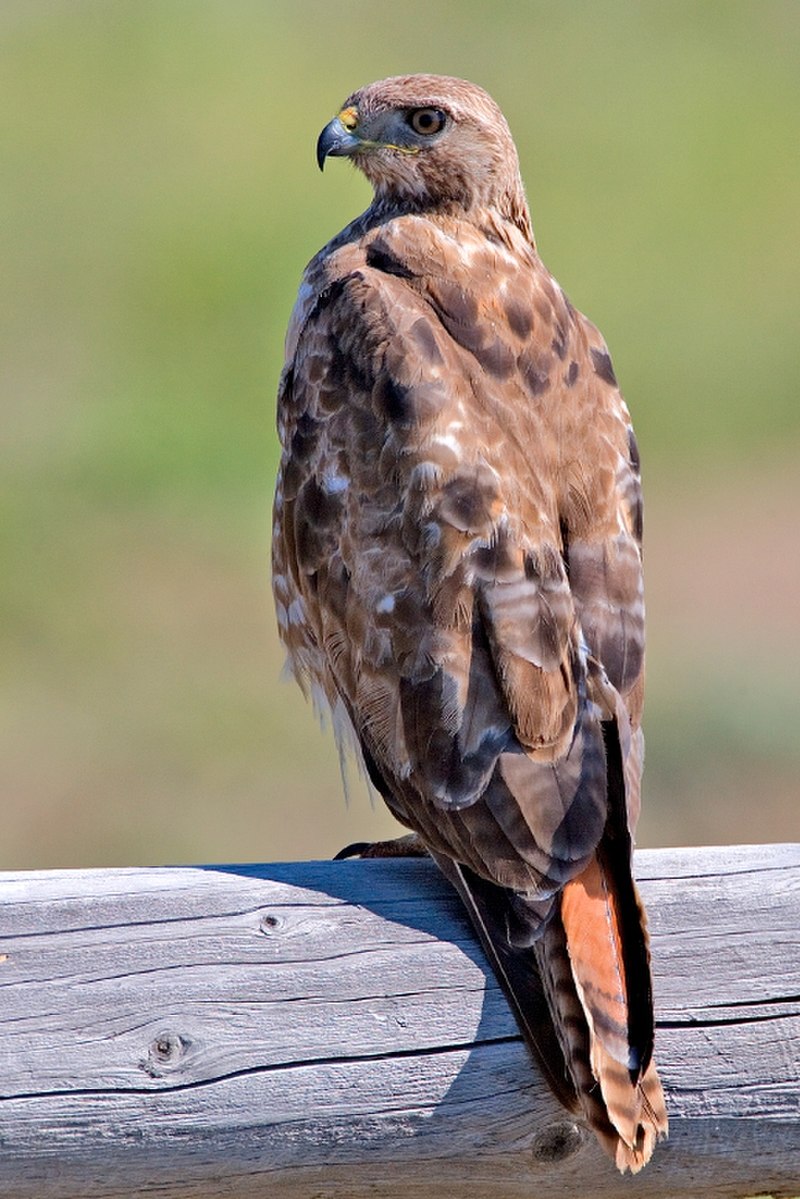
The Red-tailed Hawk is a majestic bird of prey with a distinctive red tail. It can be found throughout North America, from Alaska in the north to Panama and the West Indies in the south.
This species belongs to the Buteo genus, which makes it one of the most common raptors on Earth.
These hawks mainly hunt small mammals such as rabbits or squirrels but also feed on reptiles and birds during migration season.
Unlike other predator birds, they prefer open areas for hunting like fields or grasslands rather than dense forests.
They build their nests high up on trees where they stay all year long unless disturbed by humans or animals nearby.
Their presence has become an iconic part of American culture due to their frequent sightings around homes and parks alike making them beloved creatures among people everywhere.
Scientific classification:
| Kingdom | Animalia |
| Phylum | Chordata |
| Class | Aves |
| Order | Accipitriformes |
| Family | Accipitridae |
| Genus | Buteo |
| Species | B. jamaicensis |
27. American Tree Sparrow
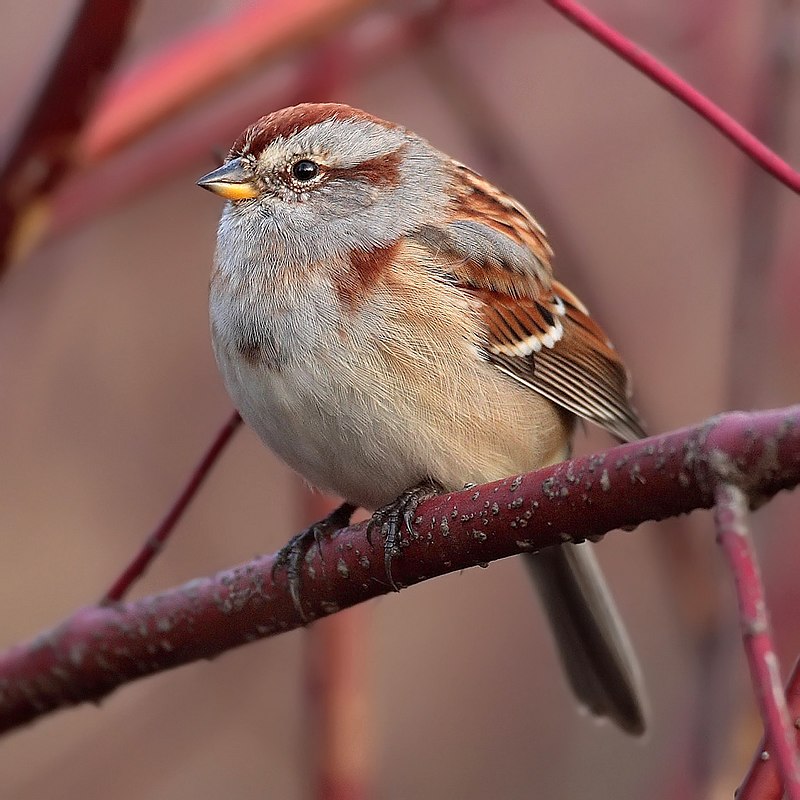
The American tree sparrow, also known as the winter sparrow, is a medium-sized New World bird. It has an attractive rusty cap and grey underparts with a small dark spot on its chest.
Its back is rust-colored and striped with lighter shades of brown while its wings have various shades of brown.
These birds are usually found in open areas such as grasslands or marshlands during spring migration and can form large flocks when seeking food sources like seeds, insects, or berries.
They nest in shrubs or trees near water sources but rarely do so far away from human settlements due to their dependence on supplementary foods provided by humans.
The American Tree Sparrow is a delightful sight for any nature enthusiast.
Scientific classification:
| Kingdom | Animalia |
| Phylum | Chordata |
| Class | Aves |
| Order | Passeriformes |
| Family | Passerellidae |
| Genus | Spizelloides Slager & Klicka, 2014 |
| Species | S. arborea |
28. Black-Capped Chickadee
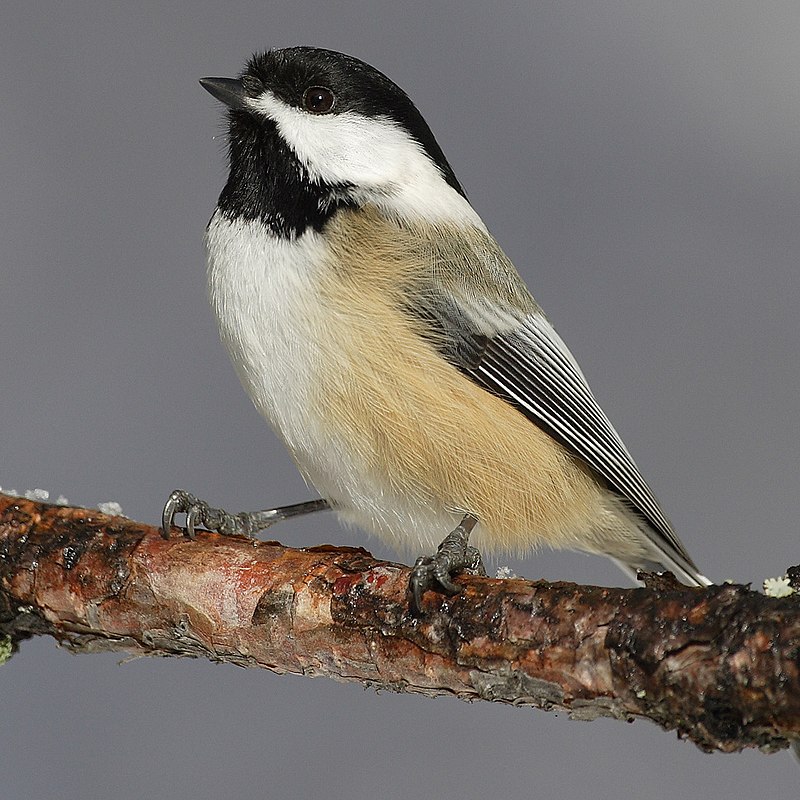
The black-capped chickadee is a small and cheerful songbird found in deciduous and mixed forests across North America. It has an iconic black cap, white cheeks, gray back, and wings with whitish bars on them.
The underparts are usually light-colored or greyish-brown. This species is well adapted to cold winters as it can reduce its body temperature by up to 8°C while roosting at night; this helps save energy during the colder months of the year.
It feeds mainly on insects but also eats seeds, fruits, and suet from bird feeders when available.
Black-capped chickadees are popular birds among backyard visitors due to their sociable nature – they often establish lifelong partnerships with one another for breeding purposes.
Furthermore, they have been designated as state birds of Massachusetts and Maine in the USA plus New Brunswick in Canada – a testament to how beloved these little avian friends truly are.
Scientific classification:
| Kingdom | Animalia |
| Phylum | Chordata |
| Class | Aves |
| Order | Passeriformes |
| Family | Paridae |
| Genus | Poecile |
| Species | P. atricapillus |
29. Great Egret
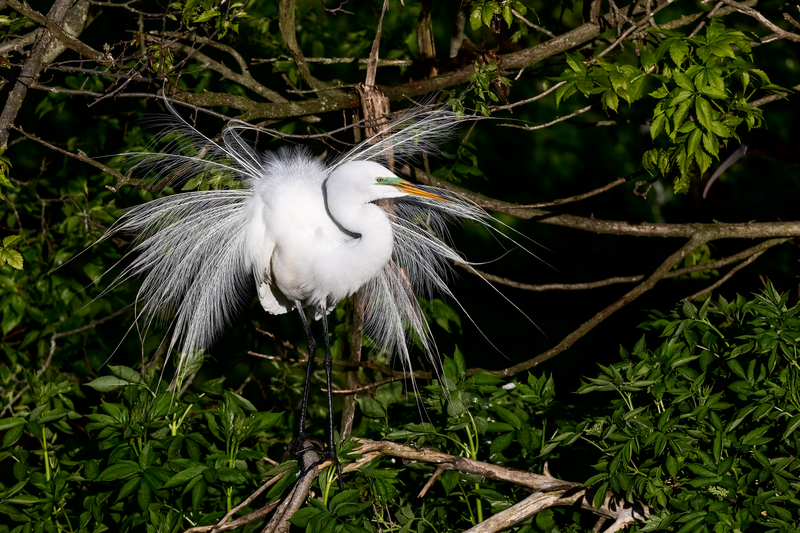
The Great Egret is a large, white bird found in many regions of the world. It has four subspecies that reside across Asia, Africa, the Americas, and southern Europe.
This species usually lives near bodies of water such as lakes and marshes. They are also now starting to spread into more northern areas of Europe due to climate change.
These birds have long yellow legs with an impressive wingspan for their size which allows them to soar majestically through the sky hunting for fish or amphibians in shallow waters below.
Their feathers have been used historically by Native Americans as part of traditional garments or ceremonies but this practice should be avoided today so these amazing creatures can thrive without harm from humans.
Scientific classification:
| Kingdom | Animalia |
| Phylum | Chordata |
| Class | Aves |
| Order | Pelecaniformes |
| Family | Ardeidae |
| Genus | Ardea |
| Species | A. alba |
30. Brown Thrasher
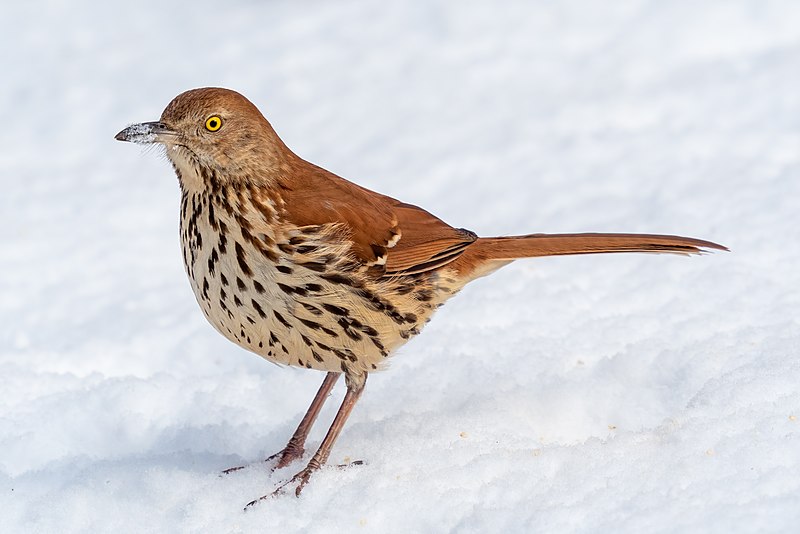
The brown thrasher is a member of the Mimidae family, along with catbirds and mockingbirds. It is found throughout much of North America in the eastern and central United States as well as southern and central Canada.
The only place that it does not inhabit is west of the Rockies or in Central Texas.
This bird can be identified by its reddish-brown back feathers, white underbelly, and long tail that often drags behind it when walking on the ground hunting for food like insects, fruits, or berries.
Its loud song consists of over 2000 different notes.
Brown Thrashers are known to build nests close to human activity which makes them easily accessible for observation making them a popular backyard species among many birdwatchers.
Scientific classification:
| Kingdom | Animalia |
| Phylum | Chordata |
| Class | Aves |
| Order | Passeriformes |
| Family | Mimidae |
| Genus | Toxostoma |
| Species | T. rufum |
31. House Wren
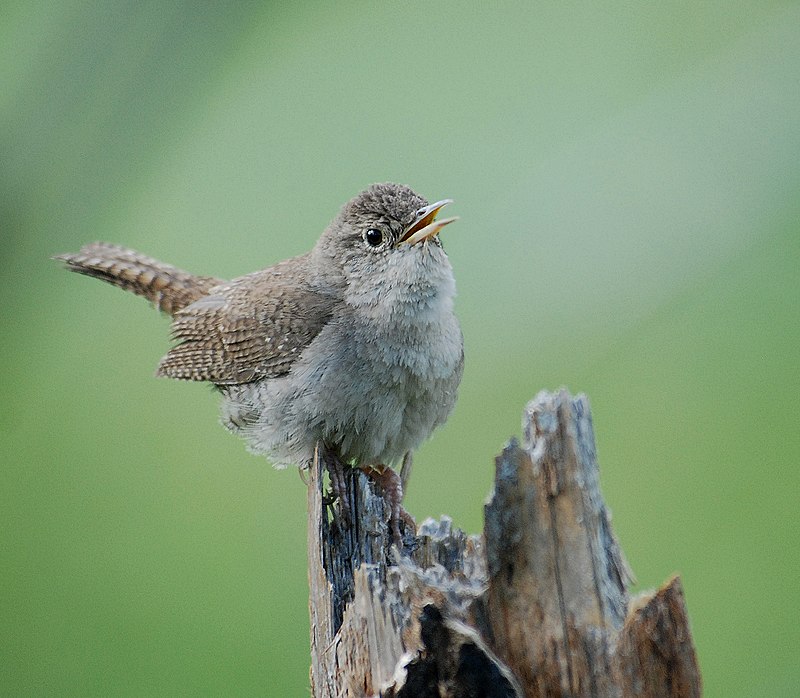
The House Wren is a small bird of the Wren family found from Canada to South America. It’s quite common in suburban areas and is one of the most widely distributed native birds in North and South America.
Its taxonomy can be complicated, with some subspecies groups considered separate species.
The House Wren has a brown back, grey head, white eyebrow stripes, light chestnut belly, and buffy flanks.
They often inhabit old or abandoned buildings as well as shrublands near fields or open woods for nesting sites.
During breeding season they are highly territorial so make sure you create an inviting environment if you wish to invite them into your yard.
Scientific classification:
| Kingdom | Animalia |
| Phylum | Chordata |
| Class | Aves |
| Order | Passeriformes |
| Family | Troglodytidae |
| Genus | Troglodytes |
| Species | T. aedon |
32. Indigo Bunting
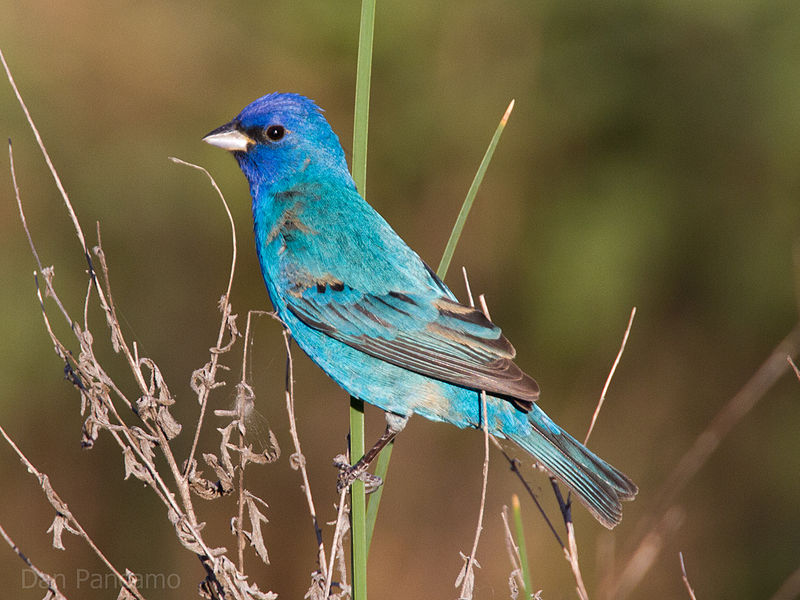
The Indigo Bunting is a small bird in the cardinal family, found throughout North and South America.
It has an unmistakable bright blue plumage that stands out against its natural habitat of farmland, brush areas, and open woodland.
During breeding season it can be seen from southern Canada to northern Florida while during winter months it migrates south towards Central and Northern South America.
The Indigo Bunting prefers to migrate at night using the stars as navigation aids.
This species feeds on insects and seeds which they find near the ground or catch mid-flight with their agile wingspan.
An iconic sight for many farmers across both continents, these birds are a welcome addition to any backyard oasis or wildflower meadow.
Scientific classification:
| Kingdom | Animalia |
| Phylum | Chordata |
| Class | Aves |
| Order | Passeriformes |
| Family | Cardinalidae |
| Genus | Passerina |
| Species | P. cyanea |
33. Red-Breasted Nuthatch
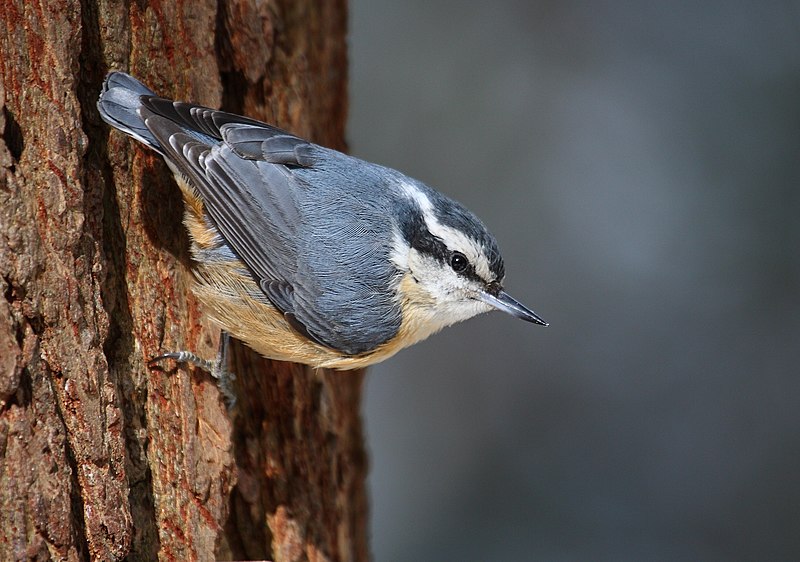
The Red-breasted Nuthatch is a beautiful and vocal songbird that can be found in coniferous forests across Canada, Alaska, the northeastern United States, and the western US.
This small bird has blue-grey upperparts with cinnamon underparts, a white throat and face with black eye stripe, a straight grey bill, and a black crown.
Its call sounds like a tin trumpet; it’s high-pitched yet nasal.
During mating season they form monogamous pairs to build their nest near tree trunks or branches at low heights off the ground where they lay 2 – 8 eggs at once.
They are very active little birds who love clinging to trees while searching for insect larvae or seeds within the bark of trees which helps control pest populations.
Scientific classification:
| Kingdom | Animalia |
| Phylum | Chordata |
| Class | Aves |
| Order | Passeriformes |
| Family | Sittidae |
| Genus | Sitta |
| Species | S. canadensis |
34. Scarlet Tanager
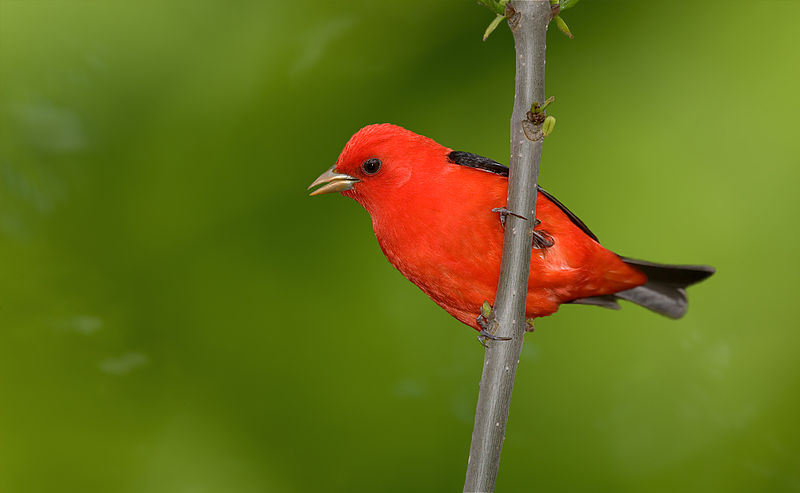
The Scarlet Tanager is a beautiful medium-sized bird found in parts of North and South America. It belongs to the Cardinal family and has striking red plumage with black wings and tail feathers.
Its song is similar to other cardinals yet also unique in its way – it’s recognizable by its high whistles that become lower towards the end.
The species feeds mainly on insects as well as berries from trees or shrubs during the breeding season, when they may form loose flocks over open woodlands foraging for food.
They are highly territorial birds during nesting season which happens between April and June each year; both males and females fiercely defend their nests against intruders such as cats or squirrels.
Scientific classification:
| Kingdom | Animalia |
| Phylum | Chordata |
| Class | Aves |
| Order | Passeriformes |
| Family | Cardinalidae |
| Genus | Piranga |
| Species | P. olivacea |
35. Eurasian Teal
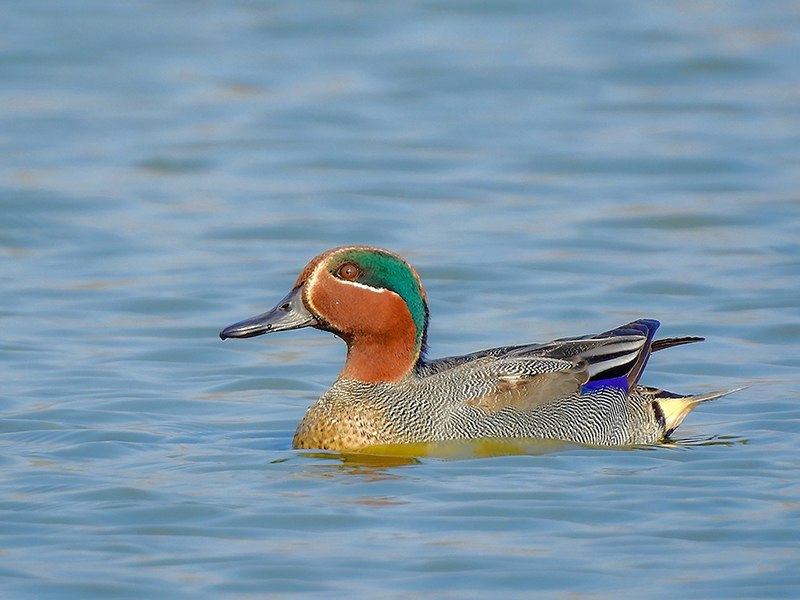
The Eurasian teal, also known as the common teal or the Eurasian green-winged teal, is a small dabbling duck that inhabits temperate Europe and Asia.
It has an unmistakable blue-green coloring which gives it its name.
During winter months they migrate south in large flocks to areas with warmer climates where there is more food available for them to feed on.
The Eurasian Teals are highly social birds; they often congregate in groups of hundreds or even thousands during migration periods.
They mostly feed on aquatic vegetation such as grasses and weeds but will occasionally hunt insects too.
These ducks make beautiful sights when flying over lakes or streams, their wings producing a distinctive whistling sound while they glide across the sky.
Scientific classification:
| Kingdom | Animalia |
| Phylum | Chordata |
| Class | Aves |
| Order | Anseriformes |
| Family | Anatidae |
| Genus | Anas |
| Species | A. crecca |
36. Pileated Woodpecker
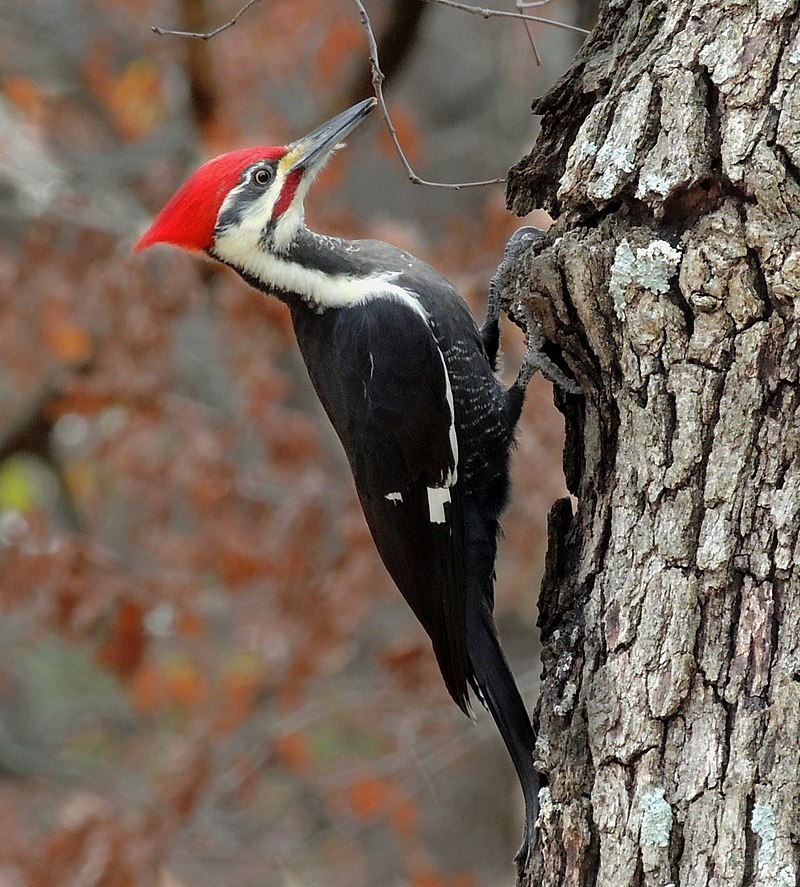
The pileated woodpecker is a large, majestic bird native to North America.
Its striking black plumage and red crest make it an unmistakable sight in the forest canopy of deciduous forests across eastern North America, the Great Lakes region, Canada’s boreal forests, and parts of the Pacific Coast.
It is one of the largest woodpeckers in North America: larger than any other confirmed species except for perhaps its relative; the ivory-billed woodpecker.
Insectivorous by nature, this stunning creature can be seen pecking away at tree trunks searching for food, or making nest cavities – all with remarkable skill.
The pileated woodpecker truly stands out as a symbol of beauty and resilience amongst our avian wildlife.
Scientific classification:
| Kingdom | Animalia |
| Phylum | Chordata |
| Class | Aves |
| Order | Piciformes |
| Family | Picidae |
| Genus | Dryocopus |
| Species | D. pileatus |
37. Barn Owl
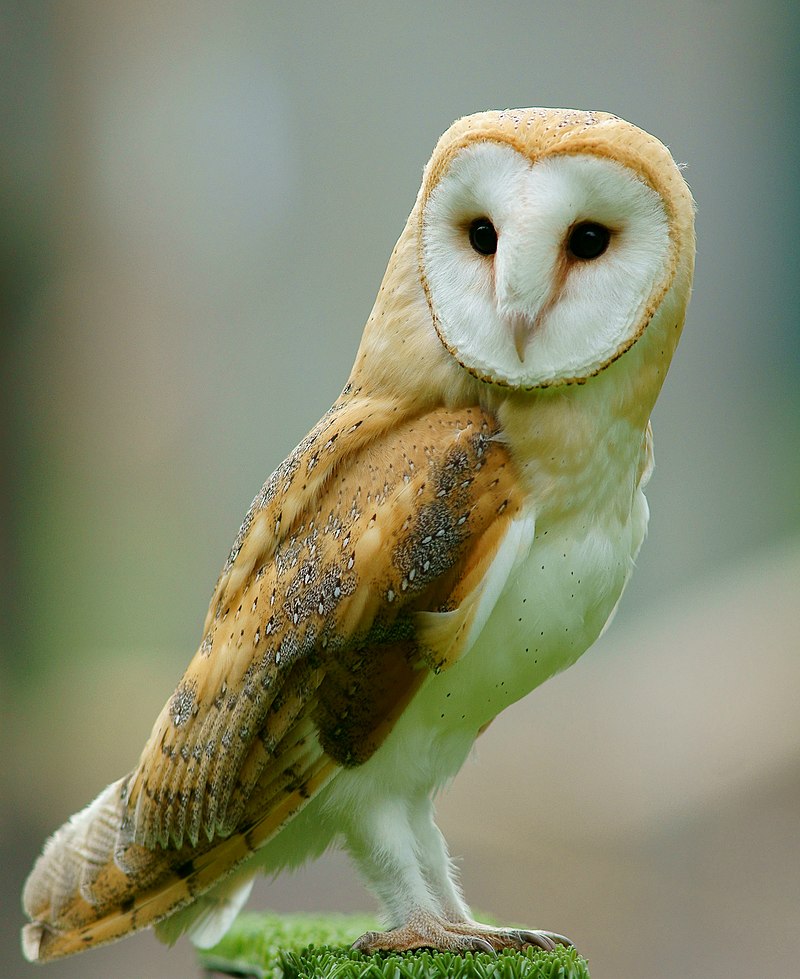
Barn owls are a beautiful and fascinating species of birds found around the world, except in polar and desert regions, most of Indonesia, and some Pacific Islands.
They have large eyes, thin legs, and long wings that help them to hunt silently in low-light conditions.
Their white coloring helps them blend into their surroundings making it easier for them to catch prey.
Barn owls are nocturnal hunters who use their impressive hearing capabilities to locate rodents moving within vegetation or tunnels beneath the ground.
They also feed on insects such as beetles, moths, etc., which they can detect from high up in flight using their excellent vision even at night time.
The barn owl plays an important role in balancing ecosystems by controlling rodent populations which is why they should be protected wherever possible so that this vital service continues uninterruptedly.
Scientific classification:
| Kingdom | Animalia |
| Phylum | Chordata |
| Class | Aves |
| Order | Strigiformes |
| Family | Tytonidae |
| Genus | Tyto |
| Species | T. alba |
38. Green Heron
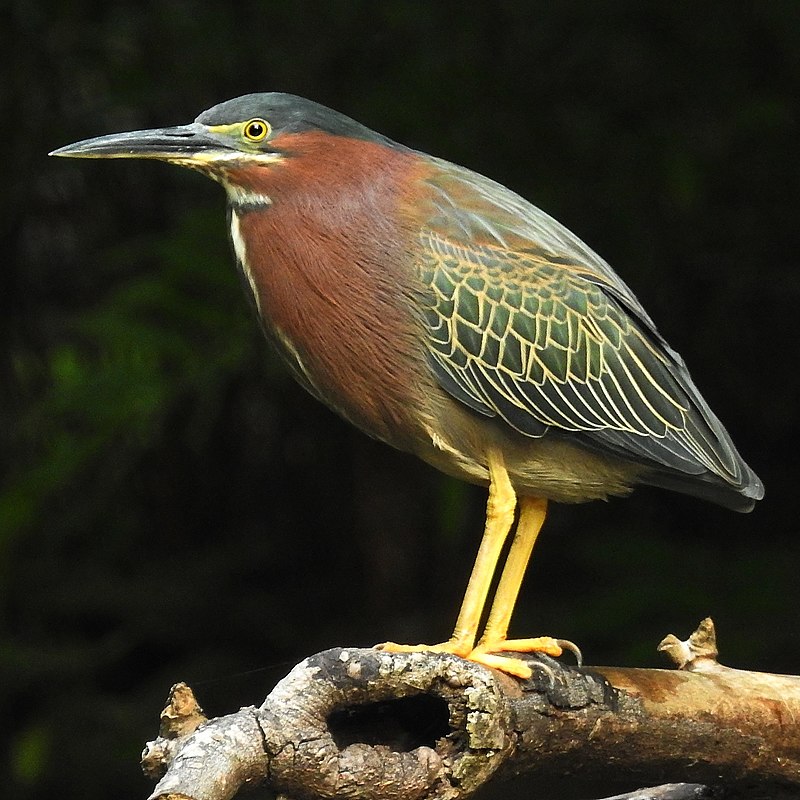
The Green Heron (Butorides virescens) is a small heron found throughout North and Central America.
Its scientific name comes from the Middle English ‘butor’ meaning bittern, combined with the Latin term for its distinctive greenish color – ‘virescens’.
For many years it was considered to be part of the same species as the Striated Heron (Butorides striata), commonly referred to as “green-backed herons”.
The nominate subspecies inhabits wetlands across much of this range, where they can be spotted stalking about in shallow water looking for fish or frogs on which to feed.
They are fascinating wading birds that have even been known to use tools such as sticks or baited lines when fishing.
Scientific classification:
| Kingdom | Animalia |
| Phylum | Chordata |
| Class | Aves |
| Order | Pelecaniformes |
| Family | Ardeidae |
| Genus | Butorides |
| Species | B. virescens |
39. Short-Eared Owl
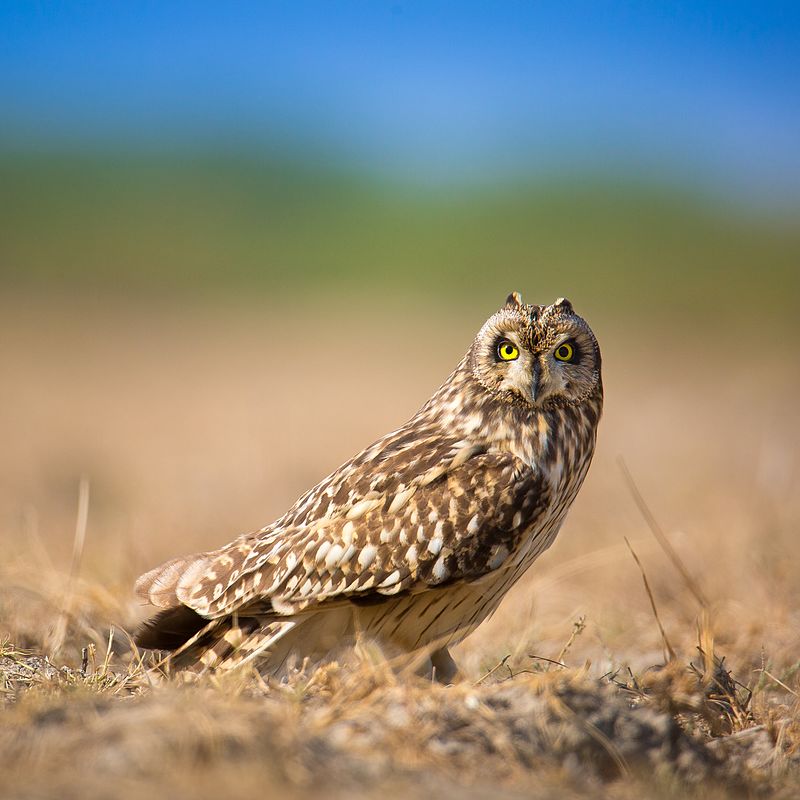
The Short-eared Owl is a species of owl belonging to the genus Asio, commonly known as ‘Eared Owls’. It has short tufts resembling mammalian ears that may or may not be visible.
When threatened they will display their tufts defensively; however, these very short tufts are usually hard to spot.
This bird can be found in grassland habitats across much of the world and hunt mainly small mammals such as voles at night by swooping low over the ground from perches like trees and posts.
They also take other prey including birds, amphibians, reptiles, and insects when available.
During breeding season males can often be seen performing aerial displays with claps of their wings while hovering above potential mates on territories it defends fiercely against intruders including humans.
Scientific classification:
| Kingdom | Animalia |
| Phylum | Chordata |
| Class | Aves |
| Order | Strigiformes |
| Family | Strigidae |
| Genus | Asio |
| Species | A. flammeus |
40. Wood Thrush
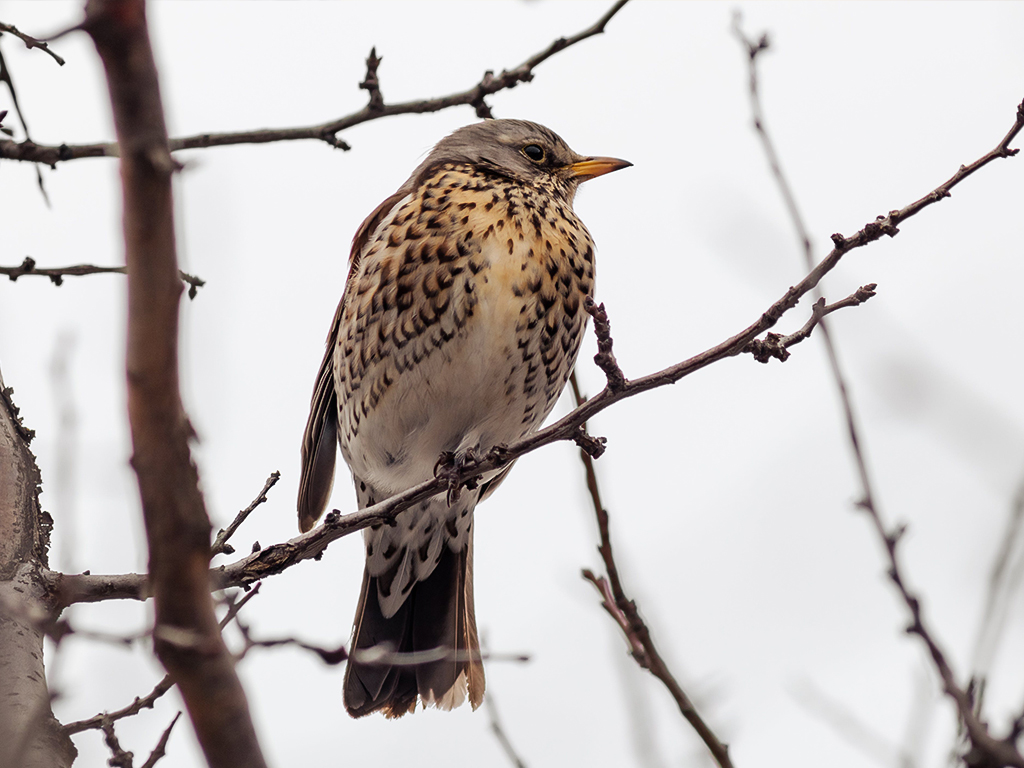
The Wood Thrush is a beautiful bird native to North America, closely related to the American Robin.
It has mottled brown and white upperparts with a spotted breast, buffy sides and flanks, and reddish-brown tail feathers.
This medium-sized thrush prefers wooded areas where it can find its favorite food – insects such as beetles, caterpillars, and spiders.
The male’s song is one of the most recognizable sounds in nature; an ethereal mix of flute-like whistles that often echoes through forests on warm summer nights.
The Wood Thrush holds special status as the official bird of Washington D.C., making it even more beloved amongst residents who take pride in seeing this exquisite species up close.
Scientific classification:
| Kingdom | Animalia |
| Phylum | Chordata |
| Class | Aves |
| Order | Passeriformes |
| Family | Turdidae |
| Genus | Hylocichla Baird, 1864 |
| Species | H. mustelina |
41. Snowy Owl
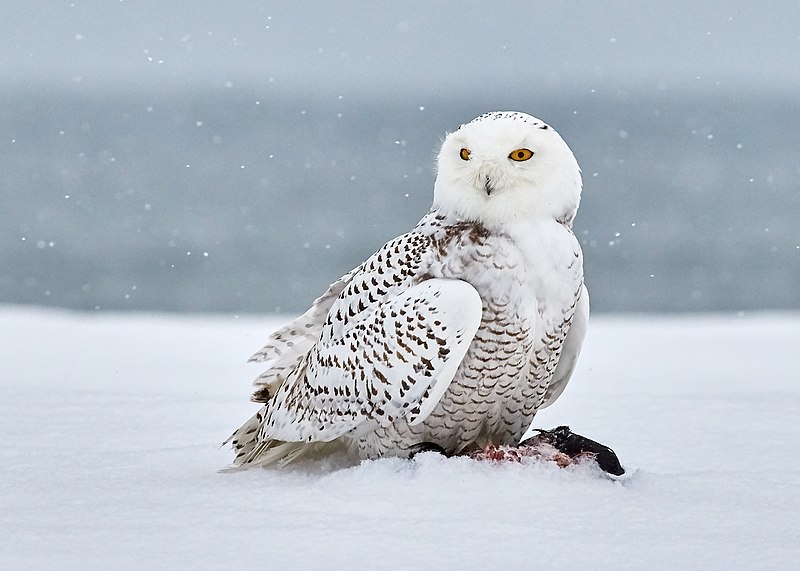
The Snowy Owl is an impressive bird of prey native to both the North American and Palearctic Arctic regions.
It has a unique white plumage that helps it blend in with its snowy tundra habitat, as well as several adaptations that make it suitable for life in cold climates.
These include thick feathers that insulate their bodies from frigid temperatures, large eyes adapted for hunting during long winter nights, and talons designed for gripping slippery surfaces such as ice or snow.
This majestic owl will soar high above its territory searching for food before gliding back down again to perch atop rocks or trees.
The Snowy Owl truly stands out amongst other birds of prey – an iconic symbol of the beauty and mystery of the north.
Scientific classification:
| Kingdom | Animalia |
| Phylum | Chordata |
| Class | Aves |
| Order | Strigiformes |
| Family | Strigidae |
| Genus | Bubo |
| Species | B. scandiacus |
Conclusion
Indiana’s avian diversity of 41 species showcases a fascinating tapestry of adaptations, behaviors, and migrations. From the Northern Cardinal’s vibrant plumage to the Peregrine Falcon’s breathtaking hunting prowess, these birds bring a wealth of wonder to the state.
They exhibit incredible adaptations like the American Woodcock’s unique courtship display and the Sandhill Crane’s remarkable migration journey.
As guardians of Indiana’s natural heritage, it is crucial to appreciate and protect these feathered residents and migrants.
By preserving their habitats and fostering awareness, we can ensure that these remarkable birds continue to grace the Hoosier state with their presence and enrich our understanding of the natural world.